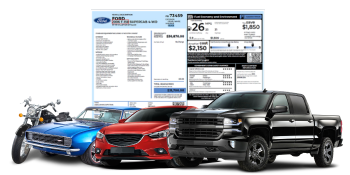Driving without power steering feels like wrestling a stubborn beast. Turning the wheel takes effort, especially at low speeds. This can make parking or navigating tight spaces a frustrating workout.
Power steering eliminates that struggle, making your car’s steering effortless and smooth. But do you know how it works or how to care for it? By understanding power steering, you’ll drive smarter and maintain your car better.
By getting a car’s window sticker by VIN, you can uncover key details about the vehicle’s features including the steering system. Now, let’s steer through the world of power steering to understand what it is, how it works, and explore its importance.
RELATED: What Trim is My Car by VIN? Window Sticker Lookup Tool
Understanding Power Steering
Power steering is a system that helps drivers turn the steering wheel with ease. It reduces the effort required to steer, even when the vehicle is stationary or moving slowly. Without power steering, turning the wheel would demand significant physical strength, especially in heavier vehicles.
This system works by amplifying the force you apply to the steering wheel. It allows for smoother handling and precise control. Whether you’re parking or cruising on the highway, power steering makes driving less tiring and more enjoyable.
Modern cars almost always have power steering. This key feature enhances both comfort and safety.
How Power Steering Works
Power steering systems use either hydraulic, electric or a combination of both technologies. Let’s break it down:
- Hydraulic Power Steering (HPS): A pump driven by the engine pressurizes hydraulic fluid. This pressure helps turn the wheels when you move the steering wheel.
- Electric Power Steering (EPS): An electric motor replaces hydraulic fluid. Sensors detect your movements and provide the right amount of assistance.
- Electro-Hydraulic Power Steering (EHPS): This hybrid system uses an electric motor to drive the hydraulic pump. It offers a balance of efficiency and power.
Each system has its advantages. Hydraulic systems feel smooth but require more maintenance. Electric systems are efficient and need less upkeep. Electro-hydraulic systems combine the strengths of both. Knowing which type your car uses helps with maintenance.
RELATED: How Efficient is Your Car Engine?
Benefits of Power Steering
Power steering transforms the driving experience in several ways:
- Effortless Steering: It reduces the physical force needed to turn the wheel. This makes driving easier, especially in tight spaces.
- Enhanced Safety: Precise control allows for quicker responses during emergencies. This improves overall safety on the road.
- Reduced Fatigue: Long drives become less exhausting because you’re not straining to steer.
- Improved Maneuverability: Parking, reversing, and navigating crowded streets becomes much simpler.
These benefits make power steering an essential feature in modern vehicles. Without it, driving would feel much more challenging.
Signs of Power Steering Issues
Power steering systems can develop problems over time. Recognizing the signs early can save you from costly repairs. Here’s what to look out for:
- Stiff Steering Wheel: If the wheel feels harder to turn, it could mean low fluid or a failing pump.
- Noises When Turning: Whining or squealing sounds might indicate a worn-out belt or low fluid levels.
- Fluid Leaks: Hydraulic systems often develop leaks. Check for puddles of power steering fluid under your car.
- Jerky Steering Movements: This could result from air in the hydraulic lines or electrical issues in EPS systems.
Address these issues promptly to prevent further damage. Your car’s maintenance manual or specs can guide you in troubleshooting.
How Window Stickers Lookup Can Help You
Understanding your car starts with knowing its original specifications. That’s where Window Stickers Lookup shines. By entering your vehicle’s VIN, you can uncover critical details, including its power steering system.
Here’s what you can learn:
- The type of power steering your car uses.
- Manufacturer specifications for power steering components.
This information helps you care for your car better. Whether it’s checking fluid levels or spotting potential issues, having the right details makes a difference. Use our window sticker by VIN lookup tool today to explore your car’s features, MSRP, and optional equipment.
RELATED: What Does MSRP Mean on a New Car?
Conclusion
Power steering plays a vital role in modern driving. It makes steering effortless, enhances safety, and reduces fatigue.
Understanding how it works helps you appreciate its value and maintain it properly. Watching for signs of trouble ensures your system stays in good shape.
When you need detailed information about your car’s steering system, the window sticker lookup is your go-to source for uncovering vehicle specifications and understanding features like power steering. Stay informed, drive safely, and keep your car in top condition.
Frequently Asked Questions
Is power steering necessary for all vehicles?
Power steering isn’t mandatory for all vehicles, but it’s highly beneficial. It’s especially helpful for larger or heavier vehicles. For most modern cars, it’s a standard feature.
What is the difference between hydraulic and electric power steering?
Hydraulic power steering uses fluid to assist steering, while electric systems rely on an electric motor. Electric systems are more efficient and need less maintenance, but hydraulic systems provide a smoother, more natural feel.
How often should I check my power steering fluid?
Check your power steering fluid every 5,000 miles or during oil changes. For the best results, follow your vehicle manufacturer’s maintenance recommendations.








